The advent of deep multiwavelength extragalactic surveys has led to the necessity for advanced and fast methods for photometric analysis. In fact, codes which allow analyses of the same regions of the sky observed at different wavelengths and resolutions are becoming essential to thoroughly exploit current and future data. In this context, a key issue is the confusion (i.e. blending) of sources in low-resolution images.
We present T-PHOT, a publicly available software package developed within the astrodeep project. t-phot is aimed at extracting accurate photometry from low-resolution images, where the blending of sources can be a serious problem for the accurate and unbiased measurement of fluxes and colours.
T-PHOT can be considered as the next generation to tfit, providing significant improvements over and above it and other similar codes (e.g. convphot). T-PHOT gathers data from a high-resolution image of a region of the sky, and uses this information (source positions and morphologies) to obtain priors for the photometric analysis of the lower resolution image of the same field. T-PHOT can handle different types of datasets as input priors, namely i) a list of objects that will be used to obtain cutouts from the real high-resolution image; ii) a set of analytical models (as .fits stamps); iii) a list of unresolved, point-like sources, useful for example for far-infrared (FIR) wavelength domains.

Example of the results of a standard t-phot run using analytical priors. Left to right: CANDELS COSMOS H-band (HRI), R-band (LRI) and residuals image obtained using Galfit two-component models. LRI and residual image are on the same greyscale.
By means of simulations and analysis of real datasets, we show that T-PHOT yields accurate estimations of fluxes within the intrinsic uncertainties of the method, when systematic errors are taken into account (which can be done thanks to a flagging code given in the output). t-phot is many times faster than similar codes like tfit and convphot (up to hundreds, depending on the problem and the method adopted), whilst at the same time being more robust and more versatile. This makes it an excellent choice for the analysis of large datasets. When used with the same parameter sets as for tfit it yields almost identical results (although in a much shorter time); in addition we show how the use of different settings and methods significantly enhances the performance.
T-PHOT proves to be a state-of-the-art tool for multiwavelength optical to far-infrared image photometry. Given its versatility and robustness, T-PHOT can be considered the preferred choice for combined photometric analysis of current and forthcoming extragalactic imaging surveys.
The latest public version is v2.0, which includes new features and options; see this page to download the code tarball. If you wish to get the previous publicly released version (v1.5.11) please contact emiliano.merlin@oa-roma.inaf.it.
Further details can be found in Merlin et al., 2015, A&A, 582, 15
